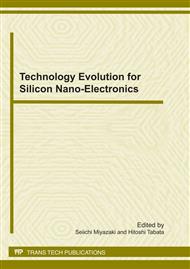[1]
R. Dennard, F. H. Gaensslen, H. N. Yu, V. Leo Rideout, E. Bassous, and A. R. Leblanc, IEEE J. Solid State Circuits, SC-9 (1974) p.256.
DOI: 10.1109/jssc.1974.1050511
Google Scholar
[2]
H. B. Bakoglu, Circuits, Interconnections, and Packaging for VLSI, (Addision-Wesley, New York, 1990).
Google Scholar
[3]
Information on http: /www. itrs. net.
Google Scholar
[4]
J. A. Davis, V. K. De, and J. D. Meindl, IEEE Trans. Electron Devices, ED-45(3) (1998) p.580.
Google Scholar
[5]
J. A. Davis, V. K. De, and J. D. Meindl, IEEE Trans. Electron Devices, ED-45(3) (1998) p.590.
Google Scholar
[6]
S. Amakawa, T. Uezono, T. Sato, K. Okada, and Kazuya Masu, International Workshop on System Level Interconnect Prediction (SLIP) (2007) p.1.
DOI: 10.1145/1231956.1231958
Google Scholar
[7]
H. Nakashima, J. Inoue, K. Okada, and K. Masu, IEICE Trans. E88-A(12) (2005) p.3358.
Google Scholar
[8]
K. Masu, IEICE Transactions (Denshi-Joho Tsushin Gakkai-Shi), 91(3) (2008) p.170.
Google Scholar
[9]
T. Sekiguchi, S. Amakawa, N. Ishihara, and K. Masu, J. Semicon. Tech. &Sci., 10 (2010) p.176.
Google Scholar
[10]
S. Gomi, K. Nakamura, H. Ito , K. Okada, and K. Masu, IEEE Custom Integrated Circuits Conference (CICC) (2004) p.325.
Google Scholar
[11]
H. Ito , J. Inoue, S. Gomi, H. Sugita, K. Okada, and K. Masu, IEEE International Electron Devices Meeting (IEDM) (2004) p.677.
DOI: 10.1109/iedm.2004.1419258
Google Scholar
[12]
H. Ito , H. Sugita, K. Okada, and K. Masu, IEEE Asian Solid-State Circuits Conf. (2005) p.417.
Google Scholar
[13]
T. Ishii, H. Ito , M. Kimura, K. Okada, and K. Masu, IEEE Asian Solid-State Circuits Conf. (2006) p.131.
Google Scholar
[14]
H. Ito , M. Kimura, K. Okada, and K. Masu, IEEE Symp. VLSI Circuits (2007) p.136.
Google Scholar
[15]
H. Ito , M. Kimura, K. Miyashita, T. Ishii, K. Okada, K. Masu, IEEE J. Solid-State Circuits, SC-43(4) (2008) p.1020.
DOI: 10.1109/jssc.2008.917547
Google Scholar
[16]
H. Ito , Junki Seita, T. Ishii, H. Sugita, K. Okada, and K. Masu, IEEE Int Interconnect. Tech. Conf. (IITC) (2007) p.193.
Google Scholar
[17]
T. Maekawa, H. Ito , and K. Masu, The 34th European Solid-State Circuits Conf. (2008) p.474.
Google Scholar
[18]
T. Maekawa, S. Amakawa, H. Ito, N. Ishihara, and K. Masu, Highly energy-efficient on-chip pulsed-current-mode transmission line interconnect, in J. W. Swart, editor, Solid State Circuit Technologies, pp.263-280, INTECH (2010).
DOI: 10.5772/6884
Google Scholar
[19]
K. Okada, H. Ito, and K. Masu, Advanced Metallization Conf. (AMC) (2006) pp.2-3, San Diego, CA; Advanced Metallization Conf., Asian Session (ADMETA) (2006) pp.124-125, Tokyo; MRS Proceedings: Advanced Metallization Conference 2006, pp.29-33.
Google Scholar


